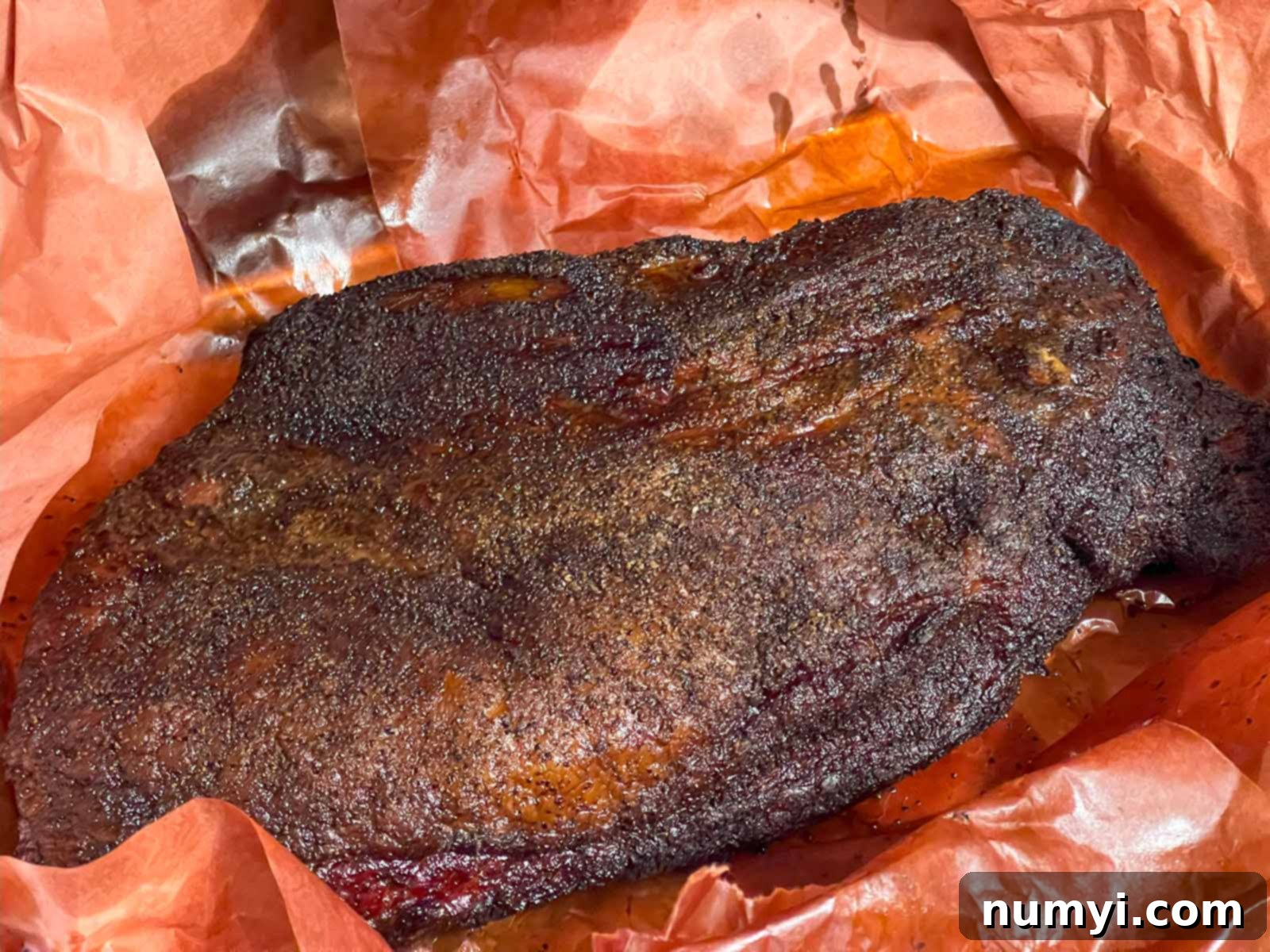Mastering Central Texas Smoked Brisket: Your Ultimate Backyard BBQ Guide
Welcome to the rich, smoky tradition of Central Texas-style backyard smoked brisket. This comprehensive guide will equip you with the knowledge and techniques to transform your backyard into a legendary barbecue destination, whether you’re a seasoned pitmaster or a curious newcomer. Prepare to embark on a truly mouth-watering culinary adventure that promises to deliver some of the best brisket you’ll ever taste.
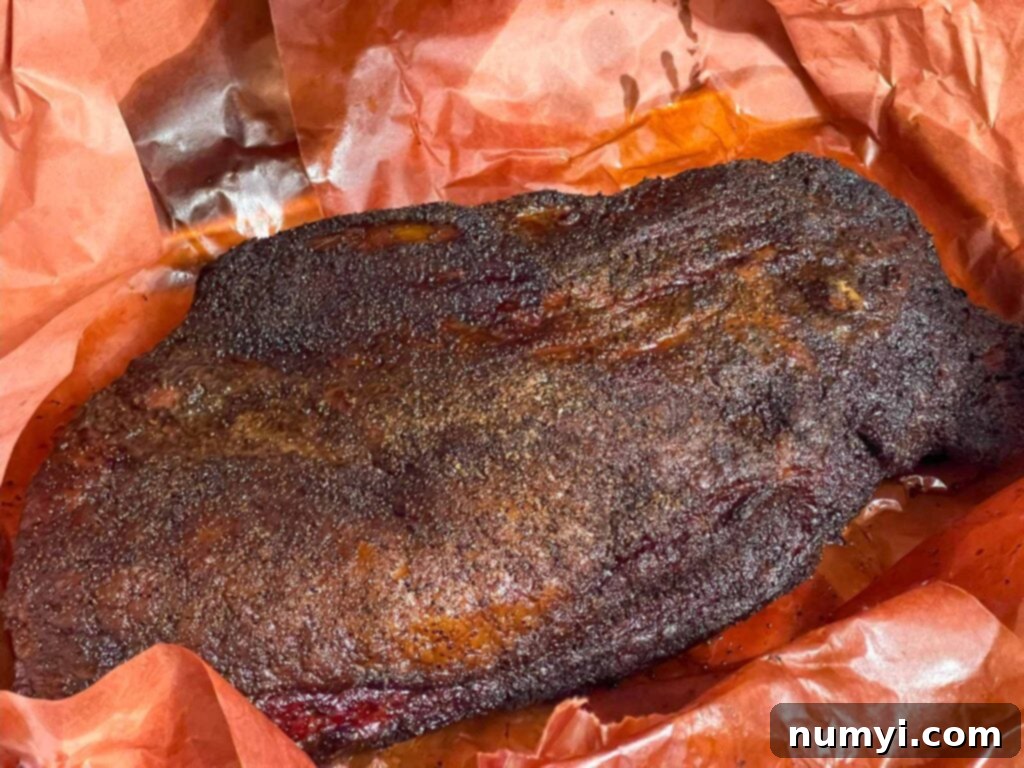
Why You Will Love This Brisket Recipe
This recipe is dedicated to the quintessential Texas-style backyard BBQ brisket. Many aspiring home cooks feel intimidated by smoking a brisket, often considered the pinnacle of barbecue. However, I assure you, with the right approach and a few simple steps, it’s not nearly as difficult as it seems.
Our recipe adheres to the pure, unadulterated Central Texas tradition: no brown sugar, no heavy barbecue sauces, just a high-quality whole packer brisket, coarse kosher salt, coarse black pepper, and a hint of garlic powder. This minimalist seasoning allows the rich, beefy flavor and the smoky essence to truly shine.
We’ll be focusing on a packer-cut brisket, which includes both the lean flat and the marbled point. This ensures a diverse texture and flavor profile in your final product. As I write this, I’m already envisioning the delicious possibilities for leftovers: juicy brisket tacos, hearty smoked brisket chili, or a savory brisket hash for breakfast. The versatility of smoked brisket is simply incredible!
By following our straightforward, low-and-slow smoking method, you’ll be well on your way to earning backyard BBQ legendary status. You’ll impress friends and family by serving a tender, flavorful brisket that rivals even the most renowned Texas smokehouses.
The beauty of this method is its adaptability. You can achieve fantastic results using a pellet smoker, an offset smoker, a gravity-fed smoker, or virtually any type of smoker. While a basic charcoal grill like a Weber might present challenges in maintaining consistent low temperatures, dedicated smokers are ideal for this technique.
Ingredients Needed
The essence of Central Texas barbecue lies in its simplicity. For this brisket, you’ll need just a few key ingredients to bring out its natural, robust flavor:
- A whole packer-cut beef brisket
- Coarse black pepper
- Kosher salt
- Garlic powder (optional, but highly recommended for an extra layer of flavor)
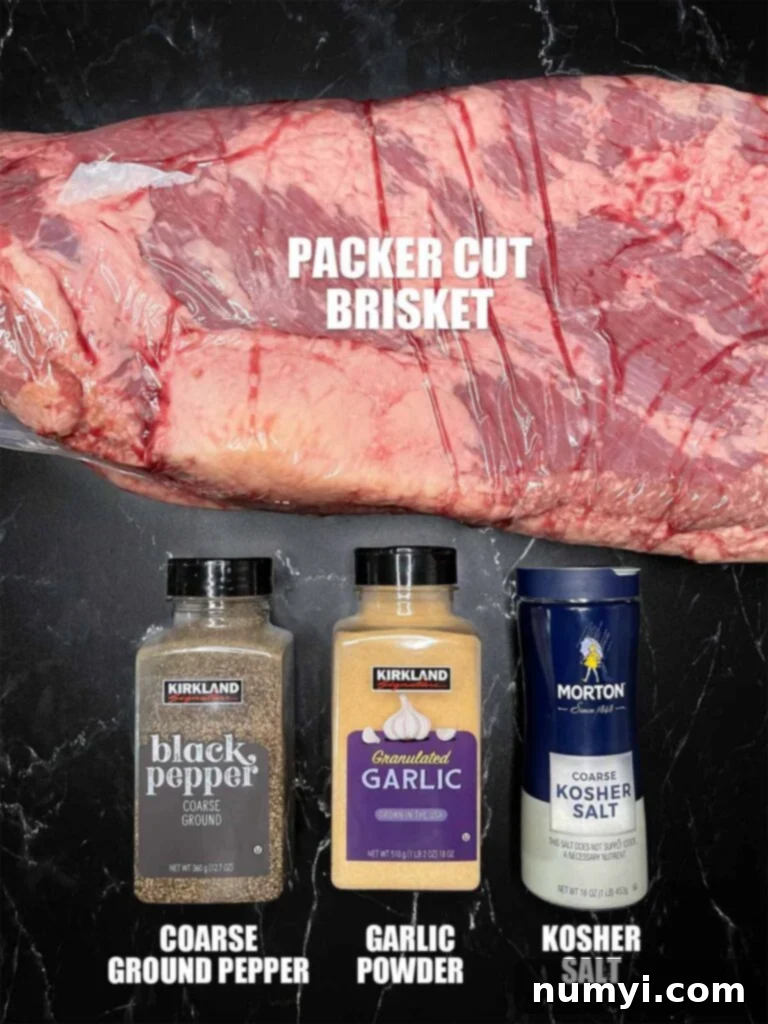
The quality of your brisket is paramount. Look for a packer cut with good marbling – streaks of creamy white fat within the lean meat – which is crucial for moisture and flavor. The fat should be firm and white, not yellowish or crumbly, indicating a fresh, high-quality piece of beef.
Understanding Backyard Barbecue Brisket Trimming
Before we dive into the trimming process, it’s helpful to understand the different approaches to preparing a brisket. Generally, there are three primary methods of trimming, each with distinct goals:
Competition Trim: This is an extremely aggressive and precise trim, focused solely on presenting a perfectly shaped, visually appealing “box” to barbecue judges. It involves removing a significant amount of fat and sometimes even meat to achieve uniformity, often sacrificing yield for aesthetics and specific bite profiles.
Restaurant-Style Trim: Similar to competition trimming, this approach is quite aggressive. Restaurants often remove a substantial amount of material, as the trimmings can be repurposed for other products like ground beef or sausage. This also ensures more consistent cooking times and uniform serving sizes for their customers.
Backyard BBQer Trim: This is where you and I come in. As home pitmasters, our goals are different. We don’t need exacting precision for judges, nor do we want to waste valuable meat. Our primary aim is to maximize the yield of our barbecue while ensuring an even cook and fantastic flavor. A whole brisket is a significant investment in both cost and time, so getting the most out of it is essential.
Don’t Sweat The Recipe is supported by its readers. We may earn a commission if you purchase through a link on our site. Learn more.
For this Central Texas style brisket, we will adopt a practical backyard trimming method. While there are specific areas to focus on, don’t get caught up in trying to achieve an “immaculate” trim. A thoughtful, efficient trim will result in a delicious brisket without unnecessary waste.
How To Trim A Packer Cut Brisket for Smoking
Trimming is often considered the most challenging part of smoking a brisket, but it’s a crucial step for a great result. Take your time, and remember, practice makes perfect.
Begin by removing the brisket from its vacuum-sealed packaging. Pat it thoroughly dry with paper towels to ensure the rub adheres properly. Place the brisket on your cutting surface with the meat side facing up. Your first task is to locate the large, dense section of hard fat known as the deckle, which is typically found between the flat and the point muscles.
Using a very sharp knife (a flexible boning knife like a Wusthof 6″ boning knife is ideal), begin to carefully remove the deckle. Make thin, shallow cuts, shaving away bits of fat at a time. The goal is to remove this hard fat because it will not render down during the smoking process and will leave a chewy, unpleasant texture. Continue cutting until the remaining fat in that area feels soft and yields easily when you press down with your fingers, rather than feeling firm and unyielding.
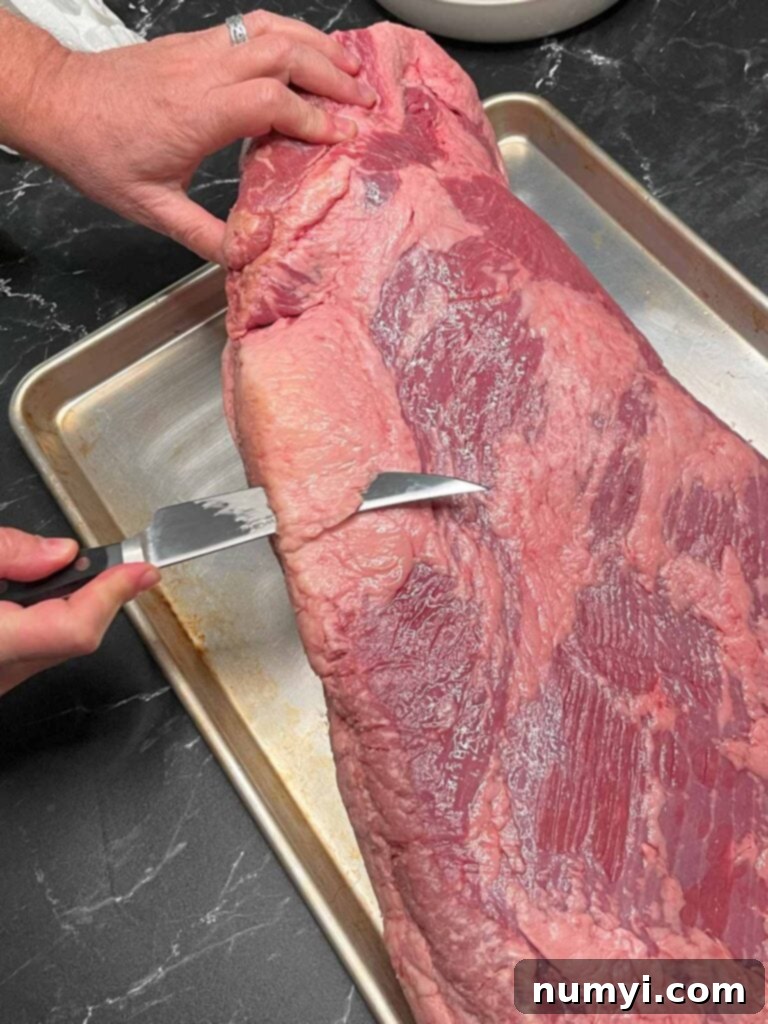
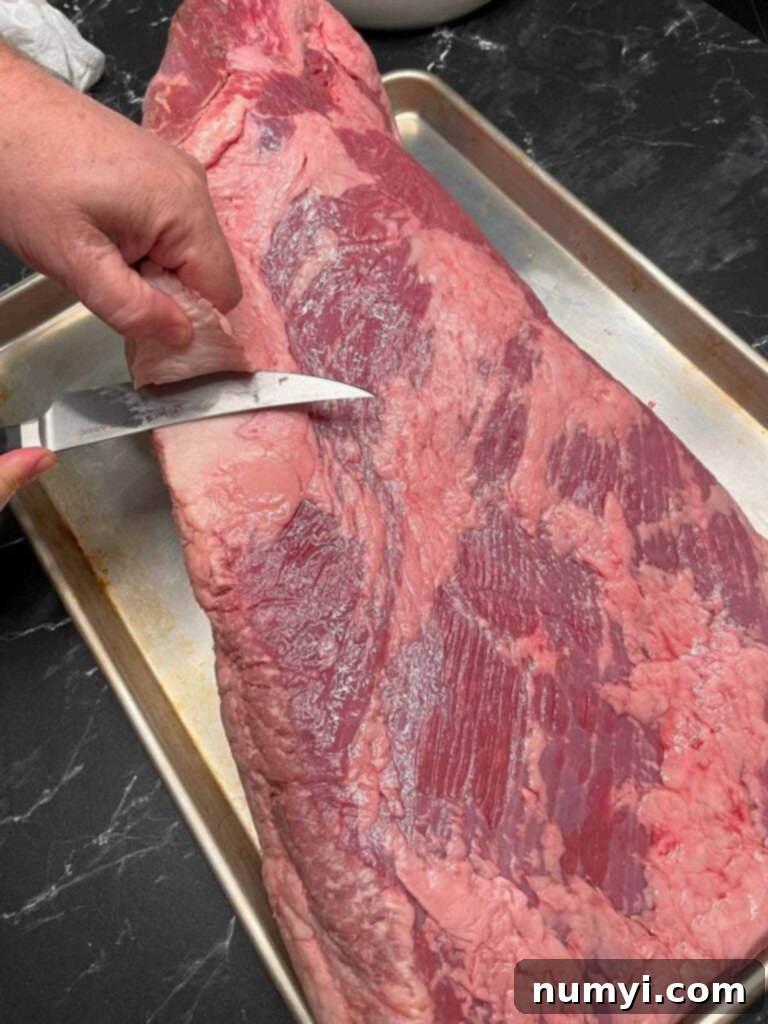
Once the deckle is removed, continue trimming the meat side of the brisket. Look for any large, irregular pieces of fat or tough silver skin. These should also be carefully sliced away. Silver skin, a thin, iridescent membrane, also doesn’t render and can create a tough exterior on your brisket.
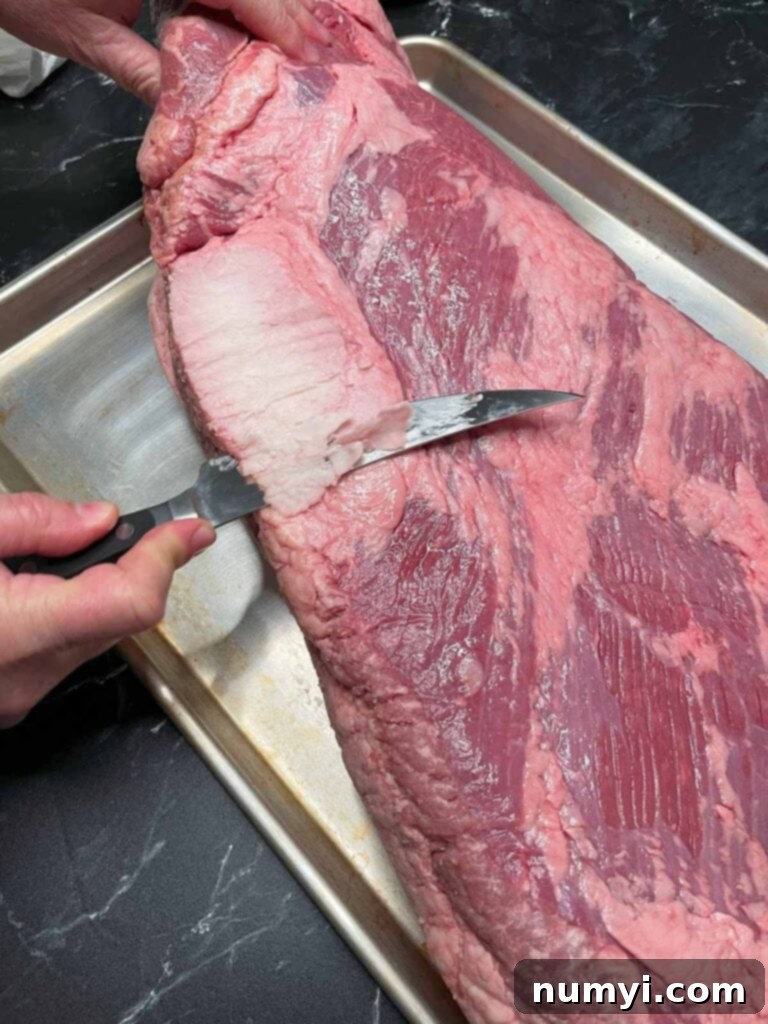
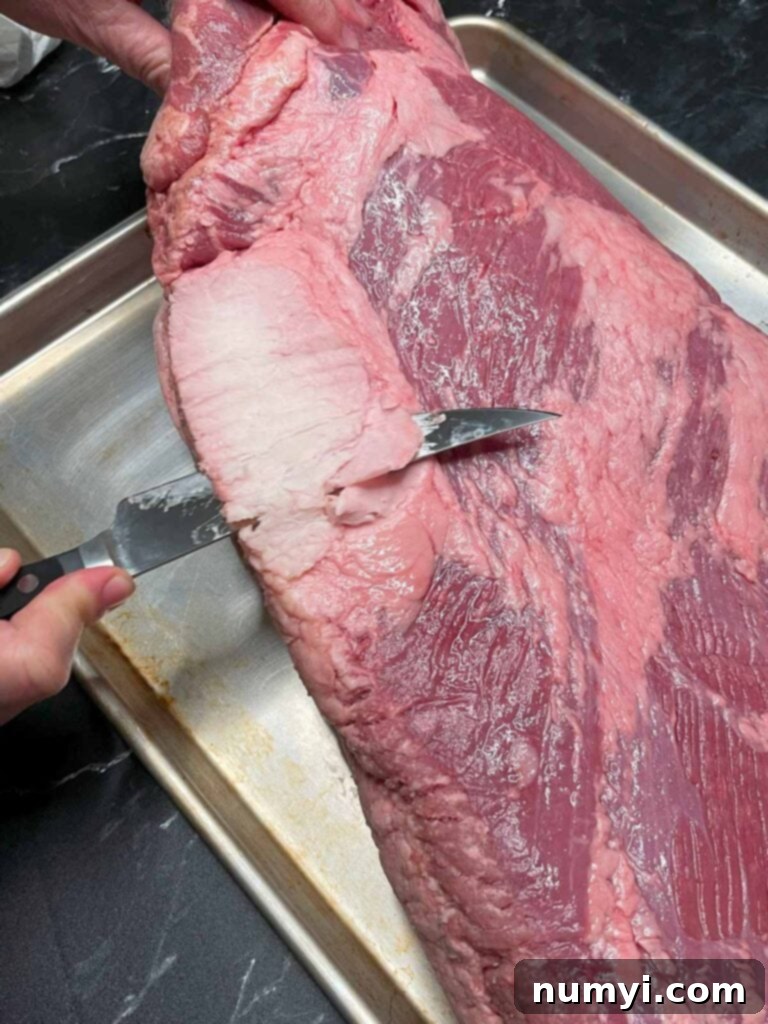
Next, identify any rough or jagged edges around the perimeter of the brisket. These areas tend to dry out and burn during the long smoking process. Trim these edges to create a smoother, more uniform shape. The cut doesn’t need to be thick; just enough to clean up the profile.
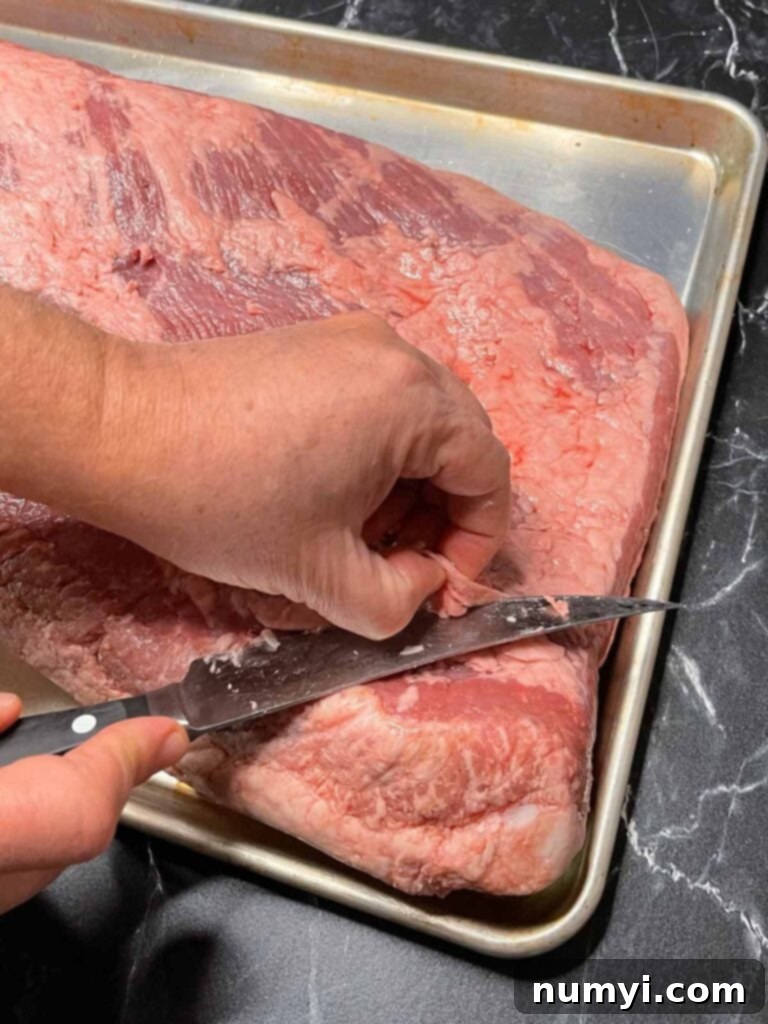
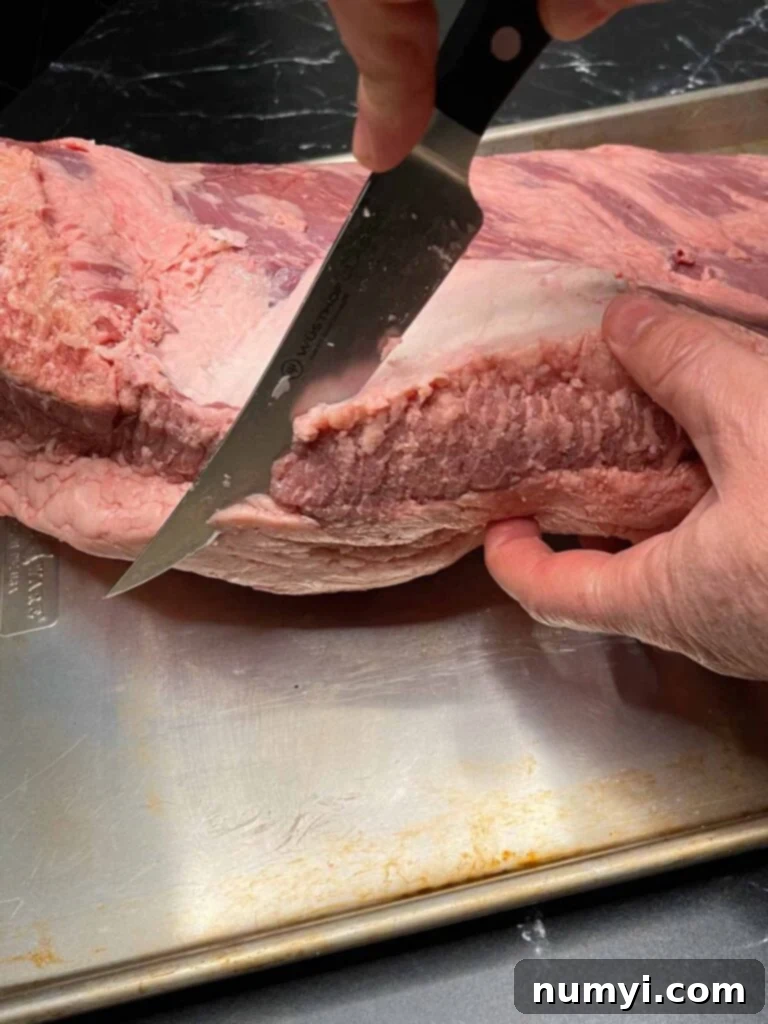
Continue to gently “massage” the brisket with your fingers, feeling for any remaining hard pockets of fat. As you find them, carefully slice them away in thin layers. The goal is to ensure the fat layer is soft and pliable, without removing all of it from the meat side.

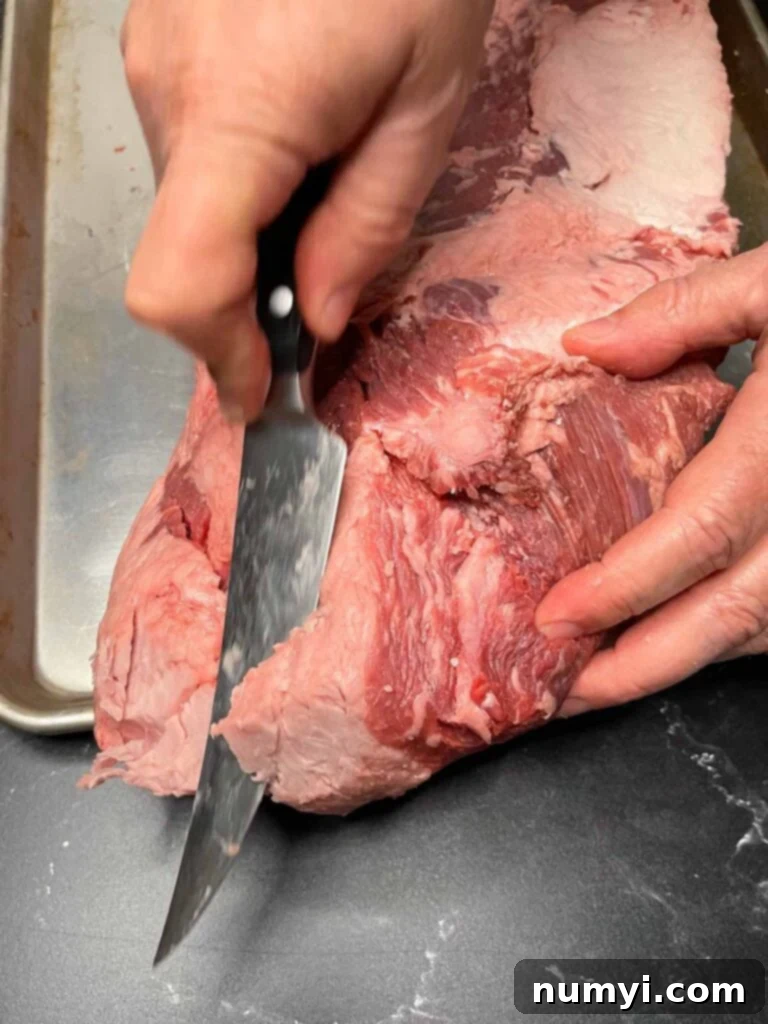
Once you are satisfied with the meat side, flip the brisket over to address the fat cap. The aim here is to leave a consistent 1/4-inch layer of fat. This fat cap will render during the long smoking process, basting the meat and contributing immense flavor and moisture. Identify the thickest areas and carefully shave off the excess fat until you reach that 1/4-inch target. The fat should feel soft and slightly yielding to the touch.

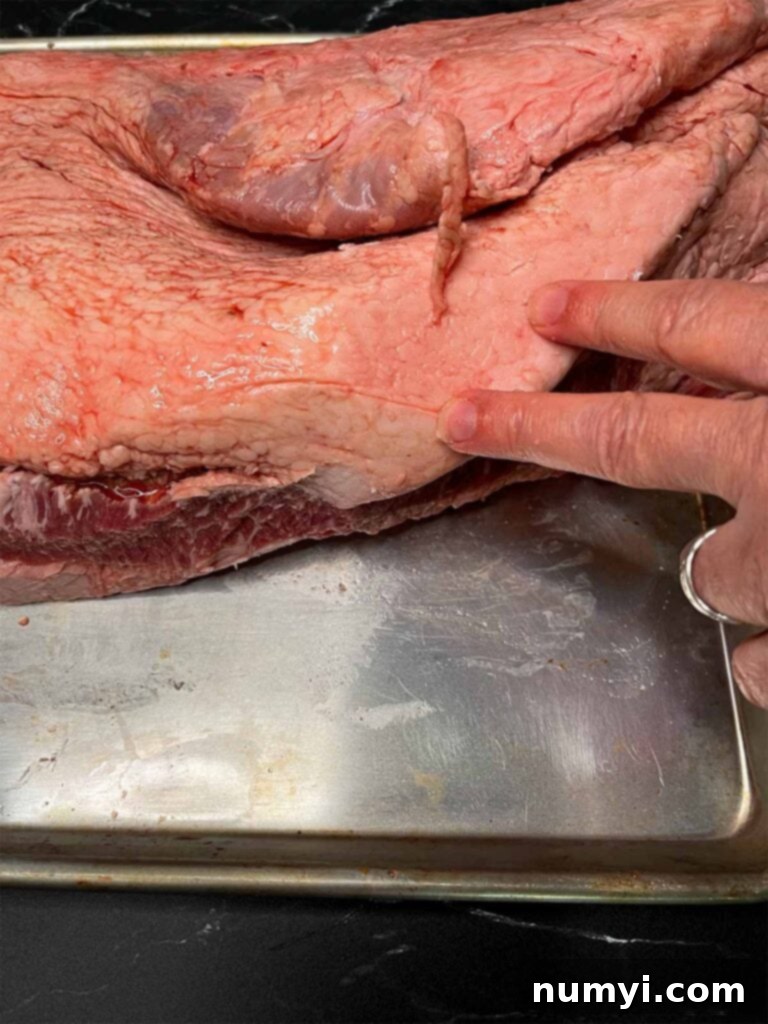
Continue working across the fat cap, meticulously removing fat as needed. Maintain that consistent 1/4-inch thickness, ensuring the entire fat cap feels soft and yielding. This uniform thickness is important for an even cook and proper rendering.
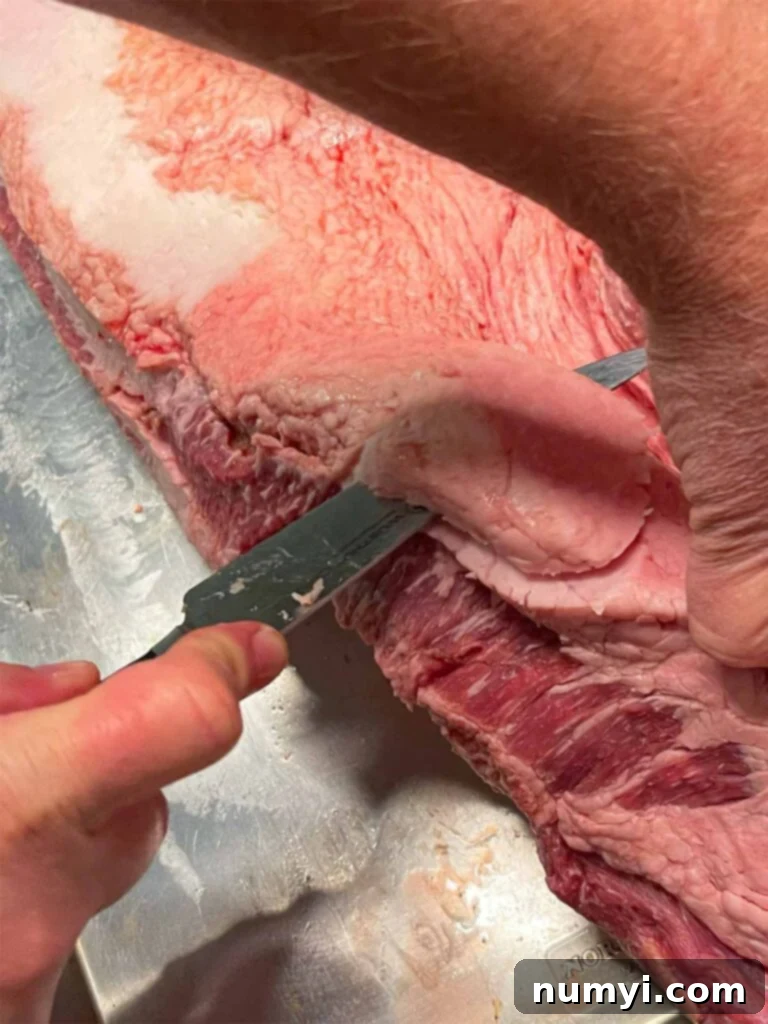
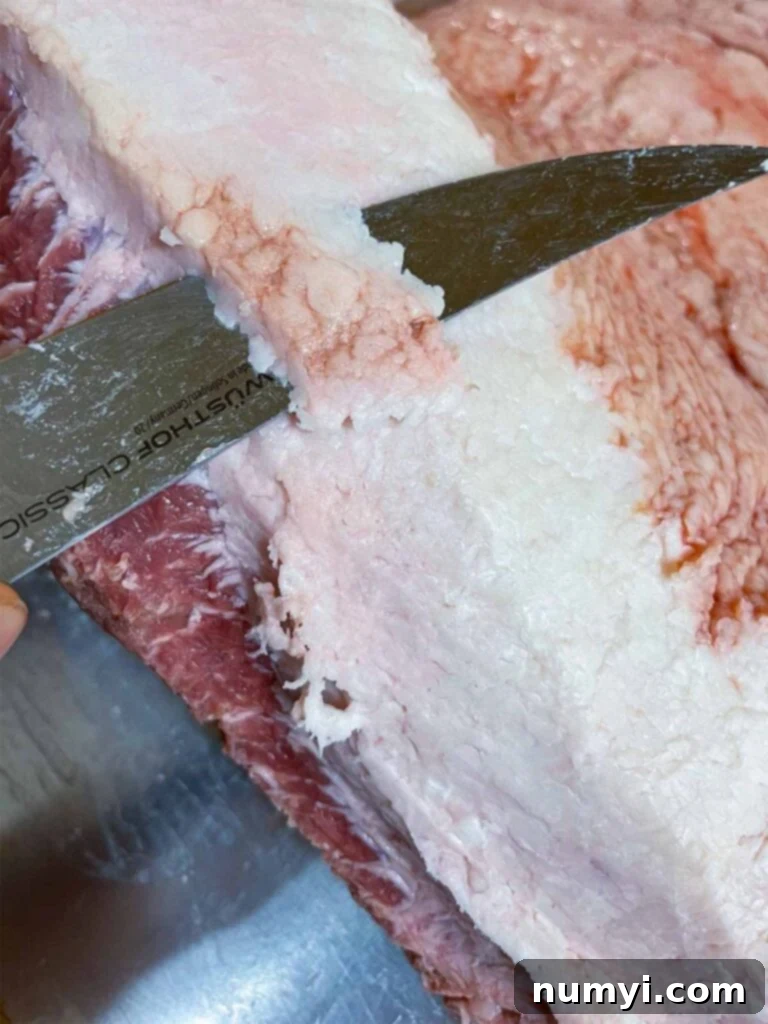
Finally, inspect the thin, flat end of the brisket. If there’s an excessively thin portion, trim it off. This part will almost certainly dry out and burn during the long smoking process. You can collect all your trimmings – both fat and lean meat – to render into tallow, grind into burgers, or add to sausage. Don’t worry about the small amount lost; you’ll still have plenty of magnificent brisket to enjoy! Ultimately, you should have a beautifully trimmed brisket, uniformly shaped, and ready for seasoning.

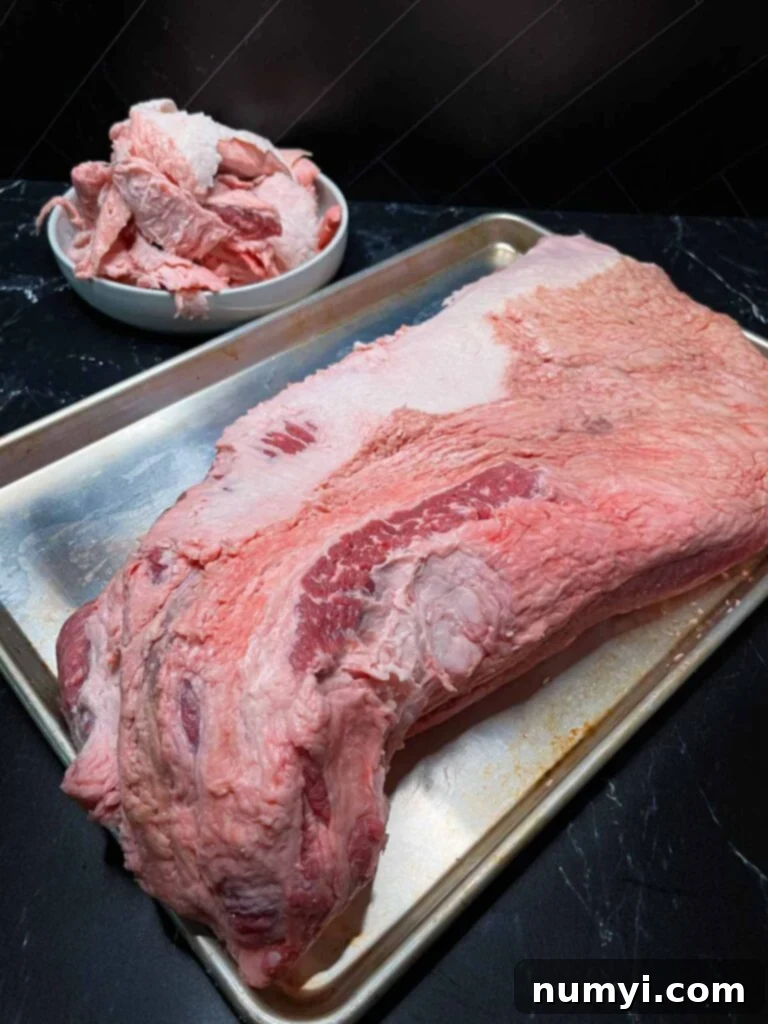
Congratulations! You’ve just completed what many consider the most challenging part of smoking a brisket: the trim. The remaining steps involve careful management of time and temperature, and with the groundwork laid, you’re set for success.
For our Central Texas brisket, we’re sticking to the traditional “Dalmatian rub” – a 50/50 mix of coarse kosher salt and coarse black pepper. I’ve also added a touch of garlic powder, which many authentic Central Texas BBQ joints incorporate, making it a perfectly proper addition!
It’s crucial to smoke the brisket fat side up. To prepare, place the brisket meat side up and apply a generous, even coating of your rub mixture. Really work it into all the crevices. Then, flip the brisket over so the fat side is up and apply another generous layer of rub to the fat cap. Don’t forget to season the sides as well, ensuring every surface is coated.
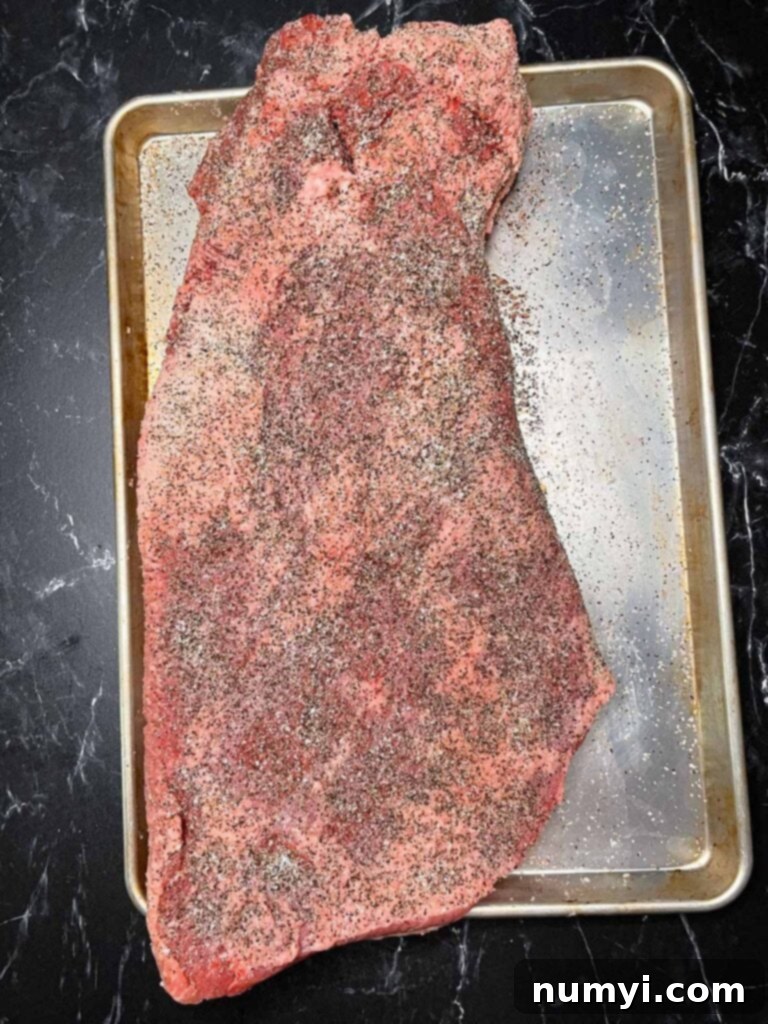
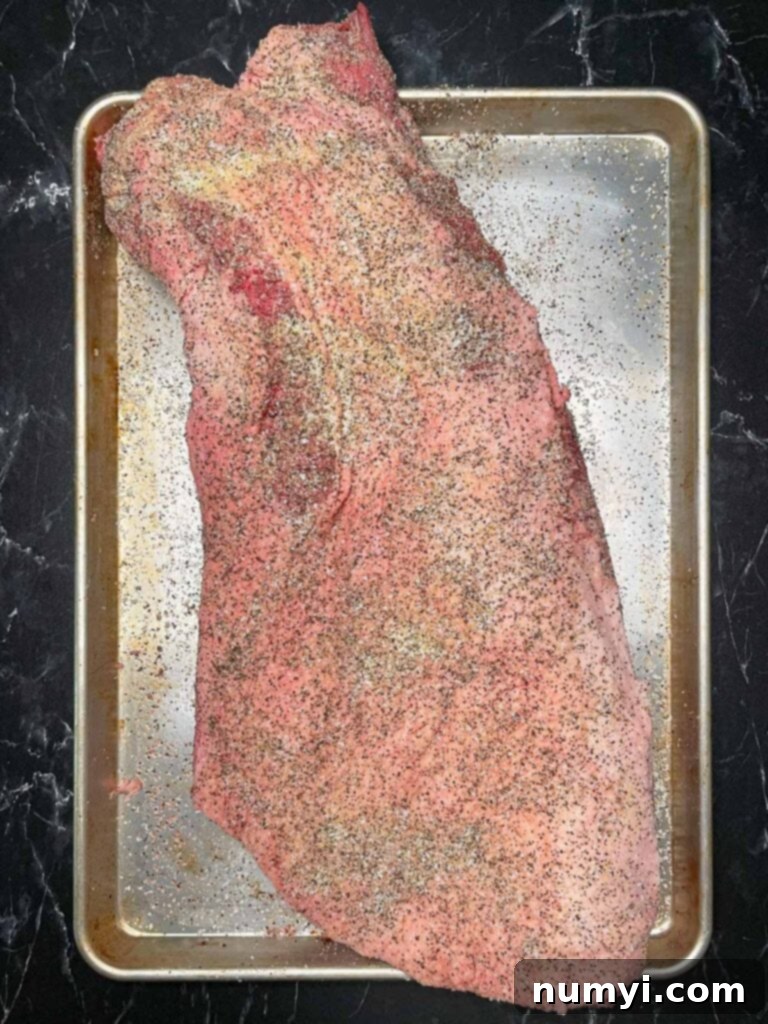
With the rub applied, your brisket is now ready for the smoker. Ideally, you might let it sit for an hour or two at room temperature before smoking, allowing the rub to adhere and the meat to warm slightly. However, if time is a factor, it’s not a critical step for a fantastic outcome. Let’s get smoking!
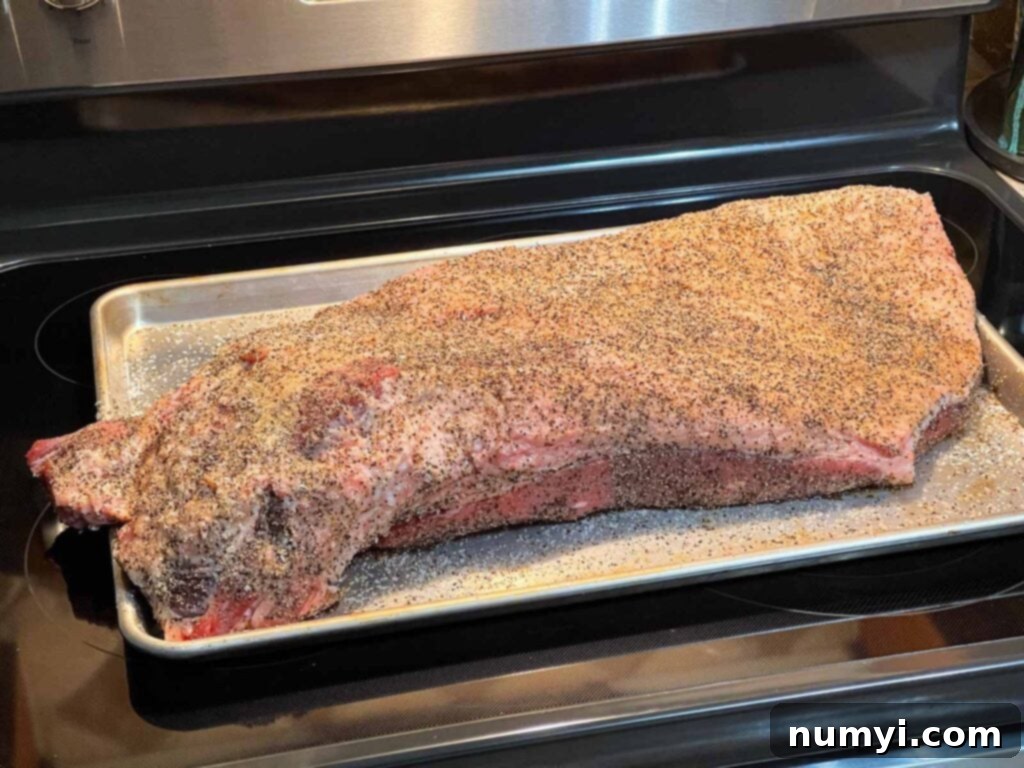
How To Smoke A Packer Cut Brisket: Low and Slow Method
This section outlines the tried-and-true low-and-slow Central Texas smoking technique. Patience is key here, as the extended cooking time at a consistent temperature is what breaks down the tough connective tissues in the brisket, transforming it into incredibly tender, juicy meat.
I recommend smoking the brisket at a steady 225°F (approximately 107°C) for the entire duration, using post oak wood. Post oak is the traditional choice in Central Texas, known for imparting a clean, mild, and distinctly beef-friendly smoke flavor. However, feel free to use your favorite wood; hickory offers a stronger, sweeter smoke, while pecan provides a milder, nutty profile. The choice of wood significantly influences the final flavor of your brisket.
Once your smoker is preheated and holding a stable 225°F, carefully place the rubbed brisket inside. Position it with the point side (the thicker, fattier end) facing the heat source. This helps to ensure a more even cook, as the point can withstand slightly more direct heat and benefits from the longer exposure.

Continue to smoke the brisket undisturbed, maintaining a consistent temperature. Avoid opening the smoker lid frequently, as each peek causes significant temperature drops and extends cooking time. Smoke until the brisket reaches an internal temperature of approximately 165°F (74°C). This typically takes several hours, and this is often when the “stall” occurs—a period where the internal temperature plateaus due to evaporative cooling.
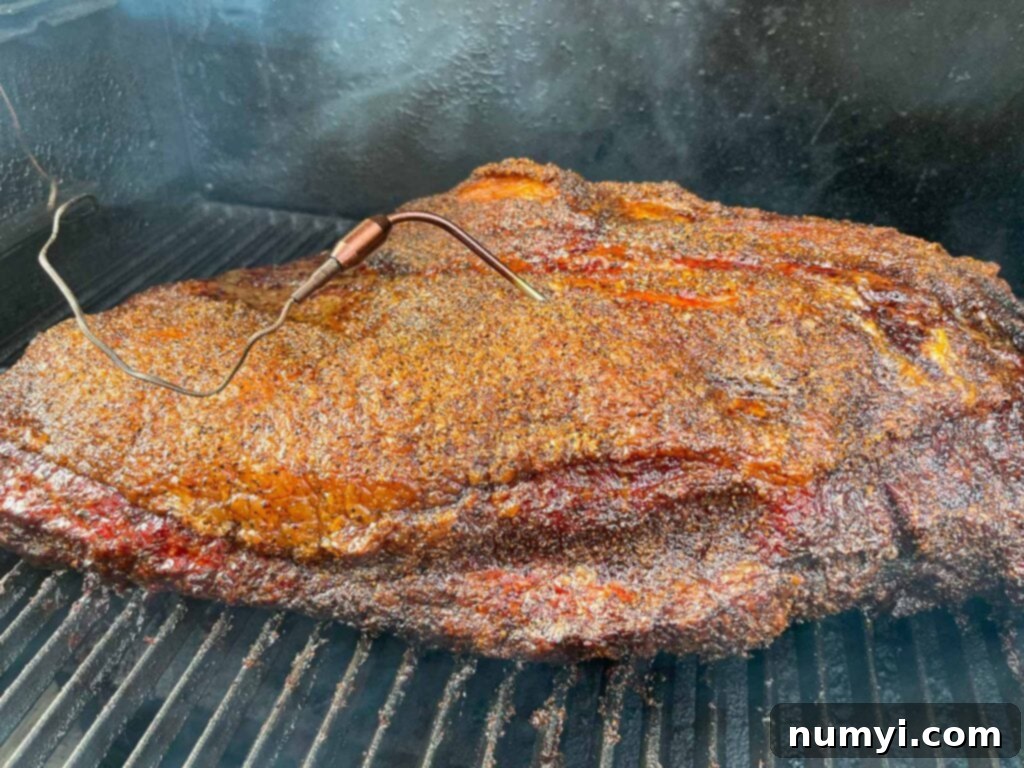
Once the brisket reaches 165°F and has developed a beautiful bark (a dark, flavorful crust), carefully remove it from the smoker. This is the time to wrap it. For authentic Texas barbecue, we use unwaxed peach butcher paper. Butcher paper allows the brisket to breathe, preventing the bark from becoming soggy, while still trapping enough moisture to tenderize the meat. Avoid using aluminum foil, as it steams the meat and softens the bark excessively. Ensure that when you wrap it, the fat side remains in the up position.
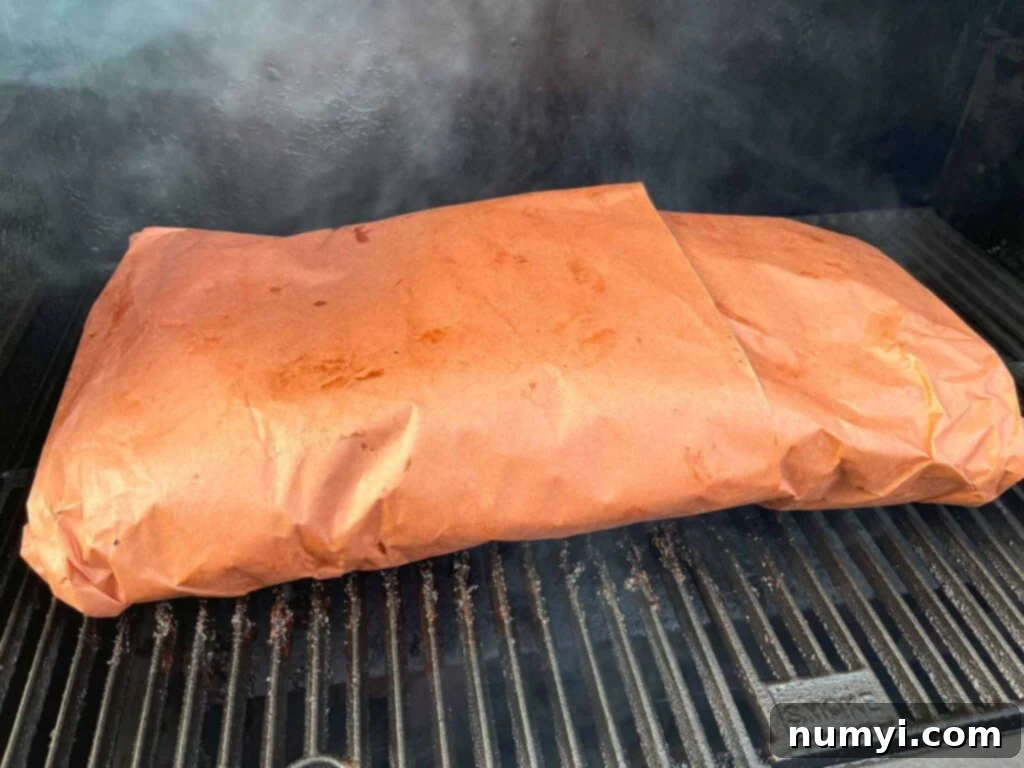
Return the wrapped brisket to the smoker and continue cooking at 225°F until the internal temperature hits somewhere around 203°F (95°C). However, temperature is only one indicator. The most crucial factor is “probe tenderness.” Insert an instant-read thermometer or a skewer into different parts of the brisket; it should feel like inserting it into warm butter, with very little resistance. If you don’t own an instant-read thermometer, now is the time to invest in one—it’s an indispensable tool for successful barbecue.
Once the brisket is probe-tender, remove it from the smoker. Now comes another critical step: resting. If you plan to eat later, wrap the butcher-papered brisket in a clean towel and place it in an insulated cooler. This method will keep your brisket warm and continue the resting process for several hours, making it perfect for parties or events.
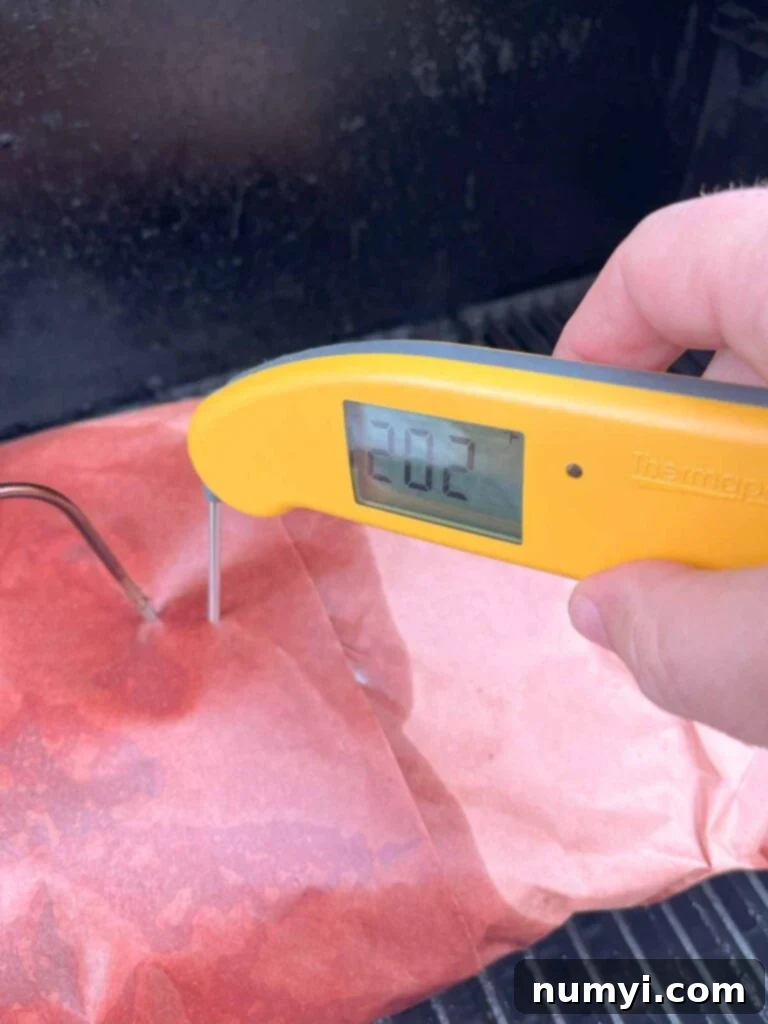
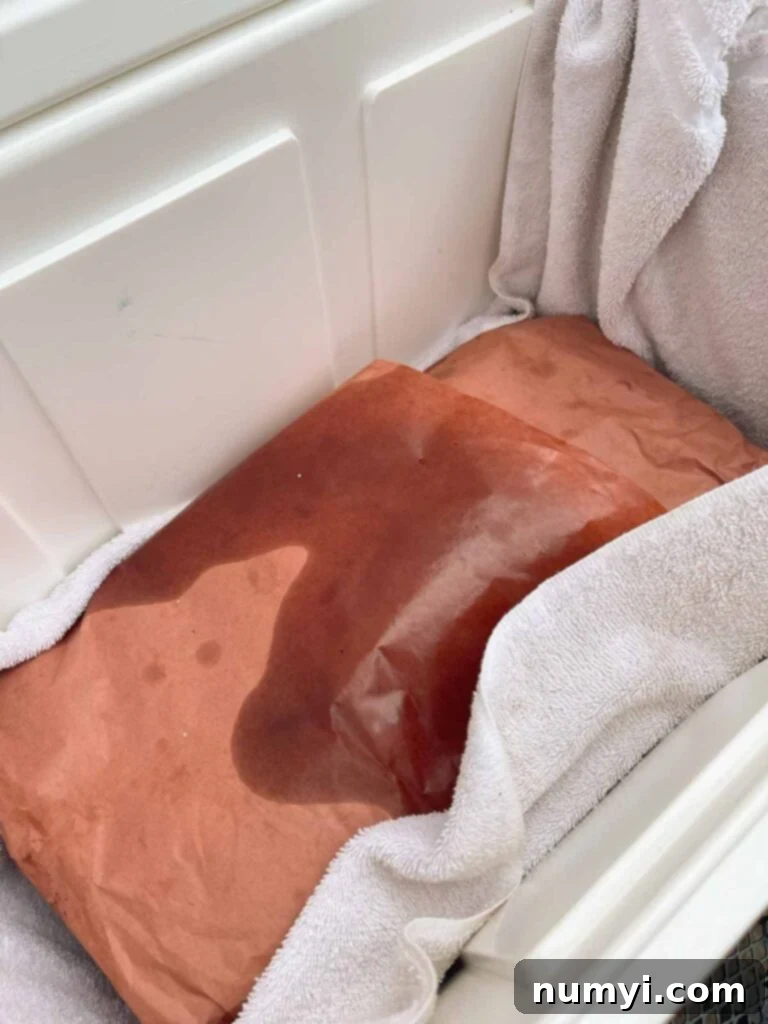
Regardless of how you hold it, the brisket absolutely needs to rest for a minimum of 90 minutes. This allows the muscle fibers to relax and reabsorb the juices, ensuring a supremely moist and tender result. Skipping the rest will lead to dry, less flavorful meat.
When you’re ready to serve, carefully unwrap the butcher paper and behold your magnificent, beautifully smoked brisket!

Place the brisket on a large cutting board. To slice, remember to cut against the grain. For the flat side (the leaner portion), aim for slices about the thickness of a pencil. This ensures maximum tenderness and prevents the meat from becoming stringy.
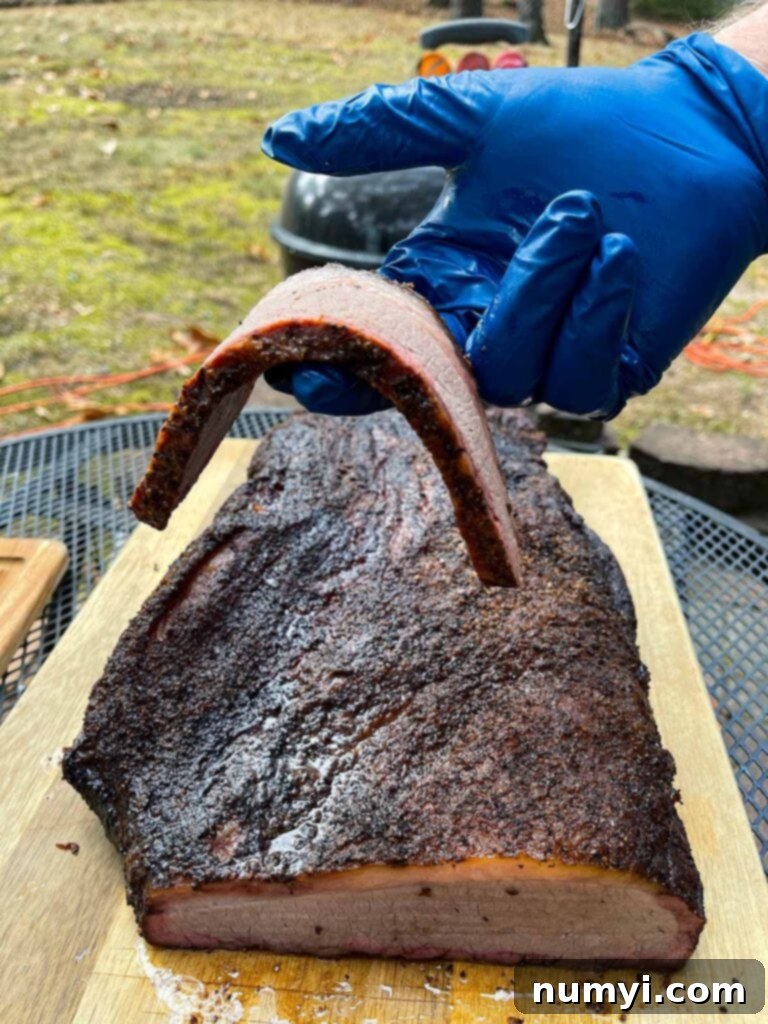
For the point side (the fattier, more marbled portion), rotate your cutting board 90 degrees. You can cut these slices a little thicker, as the extra fat contributes to its melt-in-your-mouth tenderness. Again, always cut against the grain to maximize the tenderness of each bite.
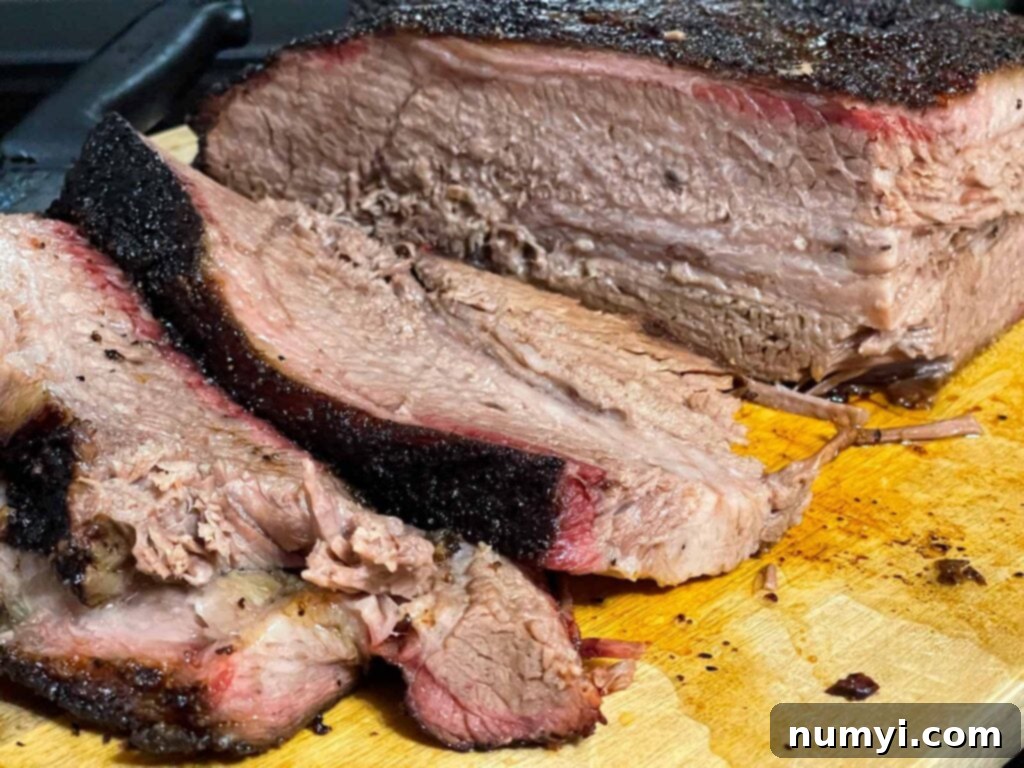
The result will be an incredibly moist, tender, and deeply flavorful piece of Central Texas barbecue meat—a true culinary triumph. Enjoy your freshly sliced brisket, and if you’re fortunate enough to have leftovers, prepare for more delicious meals in the days to come!
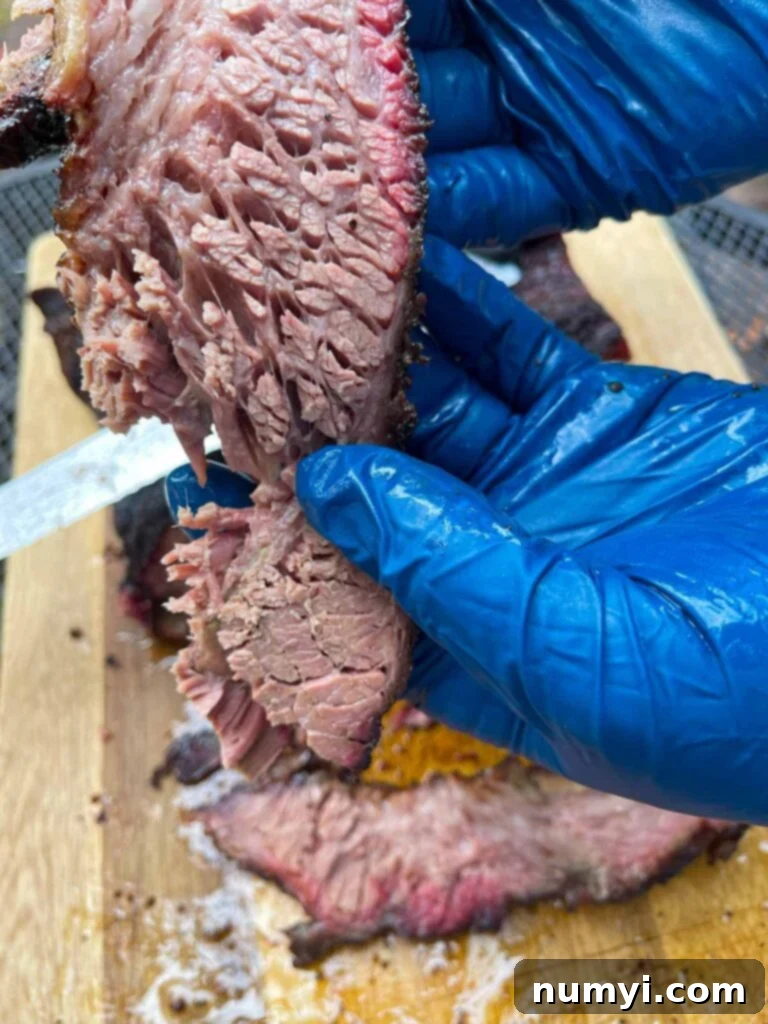
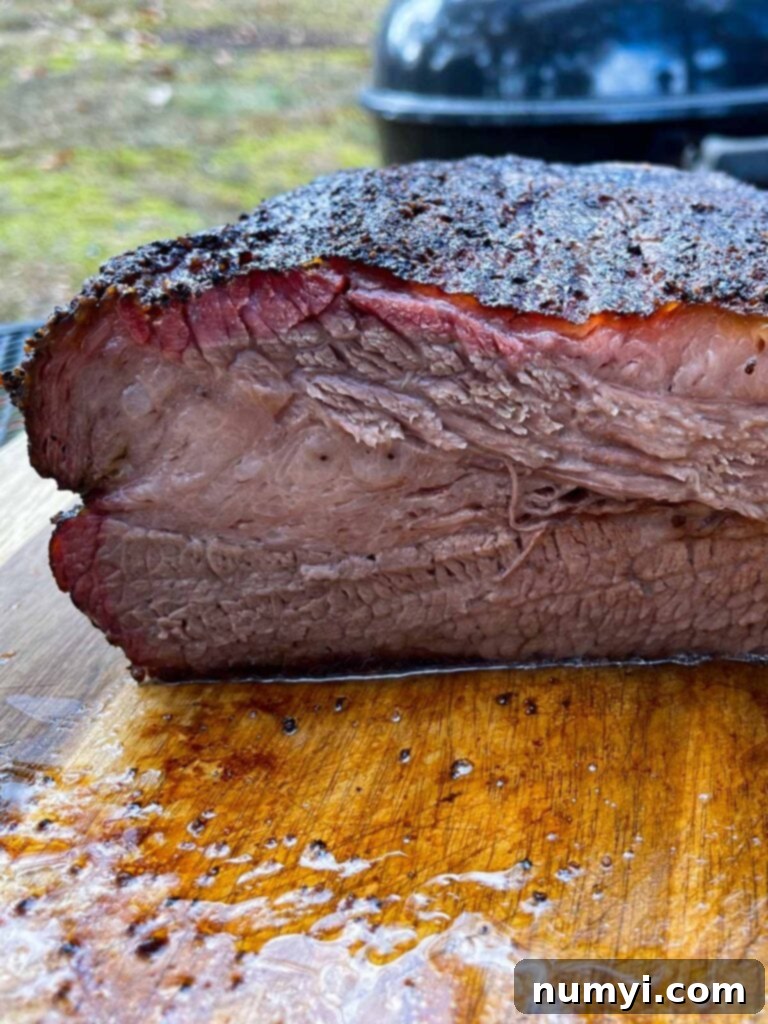
Expert Tips for Perfect Smoked Brisket
Achieving a consistently excellent smoked brisket involves a combination of art and science. Keep these crucial tips in mind for your next smoke session:
-
Picking the Right Brisket: Start with a high-quality packer cut brisket. Look for good marbling, which is the intramuscular fat that melts during cooking, keeping the meat moist and adding flavor. The fat should be a creamy white, not yellow, as yellow fat can indicate older meat or less desirable quality. A “Choice” grade brisket is a great starting point for home cooks, while “Prime” offers even more marbling for a richer experience.
-
The Art of Consistent Temperature Control: Maintaining a steady smoker temperature of 225°F is paramount. Wild temperature fluctuations can dry out the brisket or hinder proper rendering. The “stall,” where the brisket’s internal temperature plateaus, is a natural part of the process. Resist the urge to increase heat dramatically during this phase; patience is rewarded. Every time you open the smoker, heat escapes, extending your cook time. Keep that lid closed!
-
Wood Matters, Folks!: The type of wood you choose directly impacts the final flavor. In the heart of Central Texas, post oak is the gold standard for its clean, mild, yet distinct smoky profile that complements beef beautifully. Hickory offers a stronger, sweeter smoke, while pecan provides a milder, nutty flavor. Experiment to find your favorite, but always use quality, seasoned wood.
-
Strategic Trimming: Don’t go overboard with trimming. Leaving about a quarter-inch of fat cap is your golden ticket. This layer acts as a self-basting mechanism, slowly rendering during the long cook and infusing the meat with moisture and rich beefy flavor. Aggressive trimming can lead to dry brisket.
-
Simplicity in Seasoning: Central Texas BBQ is known for its purity. A simple rub of coarse kosher salt and coarse black pepper (often called a “Dalmatian rub”) is traditional. A hint of garlic powder is also a common and welcome addition. This minimalist approach allows the natural beef flavor and the smoke to truly shine, without being masked by complex spices or sugars.
-
Fat Side Up!: When placing your brisket in the smoker, position it fat side up. As the fat cap renders, it slowly drips down over the meat, continuously basting it and keeping it incredibly moist and tender throughout the long cooking process. This also helps protect the leaner flat from drying out.
-
Patience is a Virtue: “Low and slow” isn’t just a catchy phrase; it’s the fundamental principle of great smoked brisket. Rushing the cook with high heat will result in tough meat because it doesn’t allow enough time for the collagen and connective tissues to break down into gelatin, which is essential for tenderness. Plan for a long cook, often 12-16 hours for a full packer brisket.
-
Temperature and Probe Tenderness are King: While 203°F is a common target internal temperature, always prioritize “probe tenderness.” The brisket is truly done when a probe slides into the meat with minimal resistance, like pushing it through warm butter. Different briskets can be done at slightly different temperatures, so trust the feel over a strict number.
-
The Rest is Crucial: This step cannot be overstated. After smoking, allow your brisket to rest for at least 90 minutes, ideally 2-4 hours, wrapped in butcher paper and then a towel in a cooler. Resting allows the internal temperature to equalize and the muscle fibers to relax, reabsorbing the juices. Slicing too early will cause precious juices to run out, leaving you with dry meat.
-
Slice Against the Grain: This is a non-negotiable step for tender brisket. The flat and the point have grains running in different directions, so identify the grain before slicing and adjust your cutting direction accordingly. Cutting against the grain shortens the meat fibers, making each bite more tender.
-
Essential Tools of the Trade: Invest in a reliable instant-read meat thermometer and a good quality sharp knife (a boning knife for trimming, a long slicing knife for serving). Unwaxed peach butcher paper is also essential for the wrapping stage, allowing for a better bark than foil.
-
Take Notes, Get Better: Every brisket cook is a learning experience. Keep a log of your cook times, temperatures, wood choices, and results. This will help you refine your technique and consistently produce outstanding brisket.
Variations and Creative Twists
While this recipe focuses on the classic Central Texas style, celebrated for its simplicity and purity, there are a few creative variations you might explore if you’re looking to expand beyond the traditional:
-
Beer Braised Brisket: For an additional layer of moisture and unique flavor, consider a beer braise. After smoking the brisket to an internal temperature of about 165°F and developing a good bark, instead of wrapping it solely in butcher paper, transfer it to a deep aluminum pan. Pour in your favorite dark beer (stouts or porters work wonderfully), along with sliced onions and garlic. Cover the pan tightly with foil and return it to the smoker. Continue to smoke until the brisket reaches the desired probe tenderness (around 203°F). The beer not only tenderizes the brisket further but also creates a rich, flavorful braising liquid that can be reduced and served as a delicious sauce.
-
Spicy Coffee Rub Brisket: If you enjoy a bold and adventurous flavor profile, a coffee-based rub can be a fantastic variation. Start with your standard rub of kosher salt, coarse black pepper, and garlic powder, then add finely ground coffee. The coffee adds an earthy, robust, and slightly bitter note that deeply complements the beef and smoke. For a spicy kick, incorporate cayenne pepper and smoked paprika. This combination delivers a complex flavor with deep, smoky undertones and an exciting heat that’s perfect for those who appreciate a bit of spice in their barbecue.
Despite these interesting variations, I remain a purist for Central Texas style. For the absolute best results and to truly appreciate the pure flavor of beef and smoke, keeping it simple with the traditional salt, pepper, and garlic powder rub is always my recommendation.
Frequently Asked Questions (FAQ’s) About Smoked Brisket
For authentic Central Texas style barbecue, post oak is the traditional and preferred wood. It’s readily available in the region and imparts a clean, subtle, yet distinct smoky flavor that perfectly complements beef without overpowering it. However, hickory and pecan are also excellent alternatives. Hickory offers a stronger, sweeter smoke, while pecan provides a milder, nutty taste. Your choice can depend on personal preference or local availability, but all three are great for beef.
The golden rule for smoking brisket is “low and slow.” Aim to maintain a consistent smoker temperature of 225°F (approximately 107°C) throughout the cook. The total smoking time can vary significantly depending on the size and thickness of the brisket, as well as external factors like weather and smoker efficiency. A general guideline is 1 to 1.5 hours per pound of meat. However, it’s crucial to cook to internal temperature and tenderness, rather than strictly by time. The brisket is typically done when its internal temperature reaches around 203°F (95°C) and it feels “probe tender” – meaning a thermometer probe or skewer slides into the meat with very little resistance.
Proper trimming is essential for a great smoked brisket. The main goals are to remove any hard, unrenderable fat (the “deckle”), thick silver skin, and excessively thin edges that would burn. You also want to sculpt the fat cap to an even 1/4 inch thickness. Start by removing the large, hard deckle fat between the flat and the point. Then, trim any large, uneven fat deposits from the meat side. On the fat cap side, carefully shave down the fat to an even 1/4 inch across the entire surface. Finally, trim off any thin, overhanging edges from the meat itself, as these tend to dry out and become tough during the long smoke. The aim is a relatively uniform shape for an even cook and optimal bark formation.
Other Amazing Barbecue Recipes
Smoked Pork Shoulder (Pork Butt)
Fall-Apart Smoked Chuck Roast Recipe
St. Louis Ribs – Learn How To Do Smoked Ribs Like A Pro
Are you on Pinterest? Click the button below to add this recipe to one of your boards!
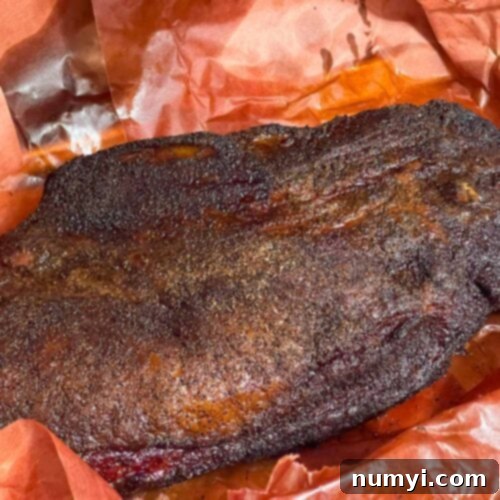
Central Texas Smoked Brisket Recipe
Print
Pin
Rate
BBQ
American
1 hour
12 hours
1 hour
30 minutes
10
303
kcal
Ingredients
-
1
Beef brisket
packer cut
-
1/3
cup
Kosher salt
-
1/3
cup
Coarse black pepper
-
2
tsp
Garlic powder
Optional
Instructions
-
Remove the brisket from its packaging and pat dry.
-
Trim the fat cap to about ¼ inch thickness, remove the deckle (hard fat), and trim off any excessively thin edges.
-
Mix equal parts of coarse black pepper and kosher salt, with a touch of garlic powder (if using).
-
Rub the mixture generously over the entire brisket.
-
Preheat your smoker to 225°F using post oak wood.
-
Place the brisket in the smoker, fat side up.
-
Smoke until the internal temperature reaches about 165°F.
-
Wrap the brisket in unwaxed butcher paper.
-
Return to the smoker until the internal temperature of the meat reaches around 203°F.
-
Remove the brisket from the smoker.
-
Allow it to rest for 90 minutes.
-
Unwrap the brisket.
-
Slice against the grain, serving slices from both the flat and the point.
Notes
Nutrition
Calories:
303
kcal
|
Carbohydrates:
5
g
|
Protein:
39
g
|
Fat:
14
g
|
Saturated Fat:
5
g
|
Polyunsaturated Fat:
0.5
g
|
Monounsaturated Fat:
6
g
|
Cholesterol:
112
mg
|
Sodium:
3918
mg
|
Potassium:
711
mg
|
Fiber:
2
g
|
Sugar:
0.1
g
|
Vitamin A:
43
IU
|
Vitamin C:
0.01
mg
|
Calcium:
47
mg
|
Iron:
4
mg
